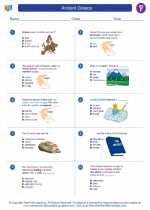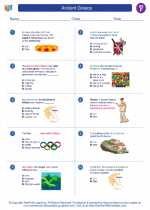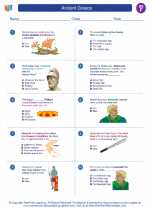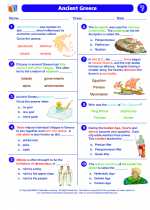Ancient Greece
Ancient Greece was a civilization that existed from around 800 BCE to 146 BCE. It was located in the eastern Mediterranean, primarily around the Greek peninsula and the islands of the Aegean Sea. The ancient Greeks made significant contributions to art, architecture, philosophy, politics, and the sciences, and their civilization has had a lasting impact on Western culture.
Key Concepts
- City-States: Ancient Greece was composed of independent city-states, each with its own government, laws, and customs. Some of the most well-known city-states were Athens, Sparta, and Corinth.
- Olympic Games: The ancient Greeks held the Olympic Games every four years in honor of the god Zeus. The games included various athletic competitions and were an important part of Greek culture.
- Philosophy: Ancient Greece was home to famous philosophers such as Socrates, Plato, and Aristotle, who made significant contributions to the study of ethics, metaphysics, and logic.
- Architecture: The ancient Greeks were known for their impressive architectural achievements, including the construction of the Parthenon, a temple dedicated to the goddess Athena, in Athens.
- Democracy: The city-state of Athens is credited with the development of the first known democracy, where citizens participated in decision-making processes and had certain rights and responsibilities.
Study Guide
Here are some key questions to help you study the topic of Ancient Greece:
- What were the major city-states of ancient Greece, and how did they differ in terms of government and society?
- What role did mythology play in ancient Greek religion and culture?
- How did the Olympic Games reflect the values and beliefs of ancient Greek society?
- Who were some of the most influential philosophers of ancient Greece, and what were their main ideas and contributions?
- What are some examples of ancient Greek architecture, and what do they reveal about the society's values and priorities?
- What were the key characteristics of Athenian democracy, and how did it compare to other forms of government at the time?
Studying the answers to these questions will help you gain a deeper understanding of Ancient Greece and its significance in history.
[Ancient Greece] Related Worksheets and Study Guides:
.◂Social Studies Worksheets and Study Guides Sixth Grade. Ancient Greece
Study Guide Ancient Greece
Ancient Greece  Worksheet/Answer key
Worksheet/Answer key Ancient Greece
Ancient Greece  Worksheet/Answer key
Worksheet/Answer key Ancient Greece
Ancient Greece  Worksheet/Answer key
Worksheet/Answer key Ancient Greece
Ancient Greece  Worksheet/Answer key
Worksheet/Answer key Ancient Greece
Ancient Greece 

 Worksheet/Answer key
Worksheet/Answer key
 Worksheet/Answer key
Worksheet/Answer key
 Worksheet/Answer key
Worksheet/Answer key
 Worksheet/Answer key
Worksheet/Answer key

The resources above cover the following skills:
National Curriculum Standards for Social Studies (NCSS)
TIME, CONTINUITY, AND CHANGE
SOCIAL STUDIES PROGRAMS SHOULD INCLUDE EXPERIENCES THAT PROVIDE FOR THE STUDY OF THE PAST AND ITS LEGACY.
KNOWLEDGE - Learners will understand:
The study of the past provides a representation of the history of communities, nations, and the world.
That learning about the past requires the interpretation of sources, and that using varied sources provides the potential for a more balanced interpretive record of the past.
That historical interpretations of the same event may differ on the basis of such factors as conflicting evidence from varied sources, national or cultural perspectives, and the point of view of the researcher.
Key historical periods and patterns of change within and across cultures (e.g., the rise and fall of ancient civilizations, the development of technology, the rise of modern nation-states, and the establishment and breakdown of colonial systems).
The contributions of key persons, groups, and events from the past and their influence on the present.
The influences of social, geographic, economic, and cultural factors an the history of local areas, states, nations, and the world.
PEOPLE, PLACES, AND ENVIRONMENTS
SOCIAL STUDIES PROGRAMS SHOULD INCLUDE EXPERIENCES THAT PROVIDE FOR THE STUDY OF PEOPLE, PLACES, AND ENVIRONMENTS.
PRODUCTS - Learners demonstrate understanding by:
Constructing a map depicting the historical expansion of a nation or empire that demonstrates an understanding of relative location, distance, direction, boundaries, major physical features, size, and shape.
National Center for History in Schools (NCHS)
Historical Thinking Standards
Chronological Thinking
Identify the temporal structure of a historical narrative or story.
Reconstruct patterns of historical succession and duration; explain historical continuity and change.
Historical Comprehension
Reconstruct the literal meaning of a historical passage.
Identify the central question(s) the historical narrative addresses.
Historical Analysis and Interpretation
Draw comparisons across eras and regions in order to define enduring issues.
Challenge arguments of historical inevitability.
Hold interpretations of history as tentative.
Historical Research Capabilities
Formulate historical questions.
Historical Issues-Analysis and Decision-Making
Identify issues and problems in the past.
Identify relevant historical antecedents.
World History Content Standards
Era 3: Classical Traditions, Major Religions, and Giant Empires, 1000 BCE-300 CE
The emergence of Aegean civilization and how interrelations developed among peoples of the eastern Mediterranean and Southwest Asia, 600-200 BCE.
The student understands the achievements and limitations of the democratic institutions that developed in Athens and other Aegean city-states.
The student understands the major cultural achievements of Greek civilization.
The student understands Alexander of Macedon’s conquests and the interregional character of Hellenistic society and culture.
Major global trends from 1000 BCE-300 CE.
The student understands major global trends from 1000 BCE to 300 CE.